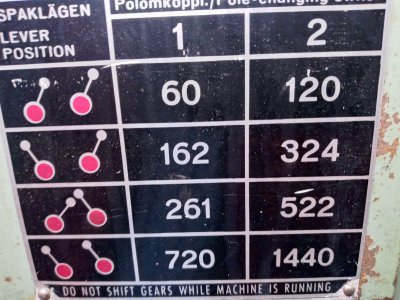My thoughts exactly but in this case, I don't think it was a bad thing (yet)
I don't mean that the motor is a bad thing, just that keeping the original pulley would have been nice... But it may not be a problem at all.
How would I know if it is correct or not? And if I could find a stepped cone pulley that had smaller/larger sizes than what is on it now, would it automatically work or not?
There's a lot of geometrical witchcraft that goes into those step pullies. A matched set will be designed (usually) to crazy wierd dimensions, with the largest or smallest (sometimes both) pullies sized to some recognizable number. The whole thing is set up in such a way that on any setting, the belt tension is correct at the exact same center distance between them. A mismatched set will require readjusting the belt tension at every speed change.
That "may" not be a problem. Most of us who are stuck with (or choose to be stuck with) a "woodworking type" drill press will play with the belt some, and eventually it migrates to the slowest possible speed (typically 250 to 400 RPM ish), and the drill press just lives in that speed for the rest of it's life. Because it works. If you're doing production runs (or hobby jobs similar to that) it might be worth moving the belt, but for just a few holes, you just make the best of it. A little slow for the tiny drills, you have to peck and cool, peck and cool when you start plowing huge drill bits at the limits of your horsepower.... But it works fine for a couple of holes.
In your case, you are gonna be WELL under 200 rpms, with you motor pulley in the top position. You also have the idler/spindle relationship to consider. You've got three ranges that will be very easy to change quite quickly. The back belt (which I suspect will mess with the overall length) could stay at the top, and you would probably have a range from very slow (to the point that those of us with "woodworking drills" would be jealous of, to probably in the 350/400 range, which is a very good range for where many drill presses literally, after the new wears off, will spend their entire lives...
~1 turn (on the spindle) to 10.5 turns (on the motor). So 1:10.5?
OK, so my calibrated eyeballs were off a little yesterday. You said (I think?) you had a motor with 1750 on the tag? That over ten and a half gets you a final reduction of 167 RPM. That puts you in the working range of as big of a drill bit as you'd want to power with that single V belt on the little pullies, and then some. So, we've determined that you should not trust my calibrated eyeballs too much, so let me suggest to set up the same sharpie marks you already made to check for the motor revolutions to spindle revolutions, but this time in slow on the motor belt (highest position on the motor and idler), and fastest remaining speed for the spindle belt (the spindle belt in the second highest position on the idler and the spindle). See what RPM that gets you calculate there. I think you're gonna like this drill press.


